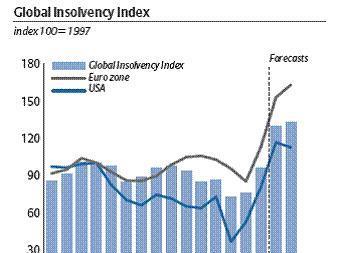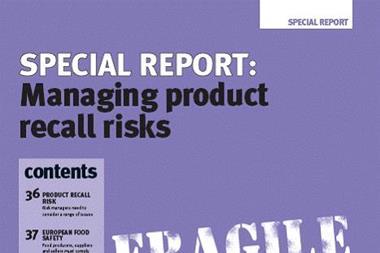Building resilience into every product. Changing business culture can be an important part of the process
Resilience of supply chains is critical to any business. It is certainly important to AZ Electronic Materials, an innovative speciality chemical manufacturing company supplying high-purity, advanced technology products used in the manufacture of integrated circuits, flat-panel displays and photolithographic printing.
AZEM has been growing rapidly following its acquisition by the Carlyle Group in 2004, and there was a need to protect this growing revenue. ‘We established our risk management programme focused initially on sound and practical risk identification. This was primarily about improving the fabric of the business,’ says Ken Greatbatch, chief financial officer.
Understanding the challenge
Through senior management workshops and risk mapping, AZEM identified that its supply chain business continuity exposures were the major risks facing the business. A business continuity programme was established as a key element of an overall enterprise risk management system.
The challenge was balancing a range of conflicting priorities and aligning the process to an existing programme of Lean Six Sigma initiatives focused on controlling working capital and improving cash flow. The procurement function was keen to secure efficiencies wherever possible. At the same time the growing expectations of customers for supply chain security had to be met, and it was important to control business interruption insurance costs.
Lateral thinking was needed to bring these elements together and avoid simply building redundancy into supply chains by building safety stock or holding excess capacity. AZEM was committed to building resilience into the fabric of the business by challenging its processes and driving business continuity thinking down to operational management levels.
Creating a resilient organisation
The focus of the business continuity project was all about ensuring resilience for AZEM’s manufacturing sites and operations. Emphasis was placed on practicality. Accountability was driven down to line management, with country presidents accountable to the chief executive for supply chain security.
Having adopted a policy in early 2006, there was a need to embed and instil a business continuity mindset within the business. Fred Mundt, vice president who focused on environment safety and health affairs (ESHA), quality and Lean Six Sigma programmes, was made responsible for implementing the business continuity process. ‘My role was all about driving global consistency and sharing best practices. With such a wide scope and a seat on the executive team, I had to ensure that my colleagues got the message and picked up the commitment.’
Engagement with senior management was key. The country president of Japan was clear that any notable interruption of operations could give rise to very significant market share erosion within a relatively short time. He was therefore very clearly motivated to make business continuity happen. Planning recovery times became a case of re-establishing supply capability within the time covered by existing stock holdings. Alternative manufacturing capacity needed to be brought on line within a very short lead-time.
As the saying goes, adversity is the mother of invention. Innovative solutions based on ‘self help’ were the order of the day. The business continuity management (BCM) framework identified available facilities within the group with the potential capability to manufacture key products at short notice. Not being able to resort to easy options, such as holding additional stock, drove managers to challenge themselves and drive down the lead time to relocate manufacturing between sites. This involved re-engineering logistics and transportation processes as well as understanding the critical limitations of manufacturing processes. Pre-planning checklists allowed the ‘rate limiting step’ in any plan to be identified and attacked. Cross-functional working between manufacturing, procurement, quality and ESHA professionals allowed new solutions to be found.
“A partnership approach and close working with the supplier were key at all times
Practice makes perfect
Success depended on everyone being clear what they were being asked to do and pulling together as a team. The business therefore set up a programme of test exercises to simulate incidents where an affected site had to call on other facilities in the group to assist in maintaining supply.
The focus was on encouraging local teams to work together to find solutions. The US country president said to Fred Mundt, ‘This process really made us think and brought the whole issue to life. My team was really energised into finding logistical solutions to what initially felt like insurmountable problems.’
The tests had two positive outcomes. The executive team received clear assurance that the plans were workable. The test outcomes are now fed into corporate key performance indicators tracking the effectiveness of key controls. Any gaps or unrealistic assumptions were quickly teased out and addressed. Equally importantly the tests provided a practical, hands-on training environment for site management to learn what responding to a crisis felt like.
Meeting the challenge
All this work bore fruit when one of AZEM’s critical suppliers suffered an explosion at one of its Asian manufacturing sites. AZEM’s local BCM team needed to rapidly come up with innovative thinking to respond to an event capable of causing significant disruption. The business continuity team met within three hours of the incident. They worked closely with customers and the supplier to manage the flow of information.
The explosion killed two people and hospitalised six more, appearing in the press around the world. Despite this, using careful production planning, supply chain professionals at AZEM were able to develop a range of options capable of meeting forecast demands. A partnership approach and close working with the supplier were key at all times. Unable to determine which way the incident would develop, the team worked with four possible recovery scenarios and established credible restart schedules for each, triggering dual sourcing arrangements to support them. The procurement director who dealt with the incident said afterwards to Fred Mundt:’Our business continuity training allowed us to react quickly, capture the incident information and make quick decisions. This gave us time to define a strategy and communicate to our customers.’ Records later showed that 80% of AZEM’s customer base had been contacted within 72 hours of the incident.
Quick action prevented a significant financial loss. However the real business value came from enhancing the company’s reputation. The electronics industry is unforgiving of failure to secure product flow but AZEM demonstrated it was a reliable supplier to its key customers. It compared very favourably to its main competitors in its response to this industry-wide issue.
Customer expectations
Like others in the industry, AZEM has experienced growing interest in its business continuity arrangements from global customers in the last 18 months.
‘We have found that having a structured approach to business continuity based around a clear policy, consistently applied across the group, has enabled us to respond to this challenge effectively,’ reports Fred Mundt. ‘Not only that but we have been commended several times by major customers following audits. They have recognised that our approach, although simple and pragmatic, represented best practice in the industry.’ This work has helped to gain and retain preferred supplier status with some key partners. It has also been recognised by a number of business continuity and risk management awards.
“Changing business culture can be an important part of the process
Suppliers – the hidden risk
The next phase of work involved recognising what many organisations have yet to fully appreciate – in an increasingly interconnected world, suppliers are the major threat to business continuity. This involved defining a new supplier evaluation process and implementing it. Recognising this was a growing issue for its customers, AZEM confirmed it was: ‘Committed to managing its supply chain in a manner that maintains the security of its supply chain for raw materials, intermediates and finished products in order to provide reasonable protection for its production capacity and brand as well as that of its customers.’
A senior procurement director was appointed to put this policy into practice. He comments: ‘I see myself as responsible for the overall supplier evaluation and risk assessment process. It is my job to ensure information is current and the audit programme is implemented, with any key risk issues escalated to executive management for action’.
This was a new and challenging area to develop. He had to establish processes whereby over 300 suppliers were contacted. The risks associated with each were evaluated and priorities identified for audit investigation. The procurement function as a whole acknowledged that there was a paradox within the management of their supply chain. They saw that the desire to have both an unbreakable supply chain and a lean and agile one required business continuity thinking to be brought together with Lean Six-Sigma techniques. Optimising the level of working capital and sourcing arrangements requires flexible thinking and cross-functional working to be successful. This requires the right culture.
It is only through engaging procurement teams in the overall supply chain risk management strategy, that these considerations can be embedded across the business. ‘Establishing standards and procedures are a necessary step, but they are not enough on their own. You need to win hearts and minds, take your people with you, change the business culture,’ adds Fred Mundt.
Business benefits realised
Business continuity thinking has been embedded within AZEM’s business. This is not just about ensuring supply chain resilience. It provides commercial advantage and differentiation with customers as well as helping ensure the business can continue to grow.
At the same time, there has been a keen eye on cost containment. Implementing business continuity arrangements consistently across the group has reduced the group’s exposures and enabled a different insurance strategy to be adopted. CFO Ken Greatbatch is left in no doubt about the financial benefits.
‘The project has allowed us to re-evaluate our insurance strategy and present to our key underwriters a coherent and pragmatic approach to business continuity management. This has resulted in our business interruption insurance programme being closely tailored to our exposures in terms of limits and indemnity periods purchased. Underwriters have recognised the quality of plans in place, resulting in premium savings in excess of 20%,’ he says.
Greatbatch concludes, ‘This approach represents an extremely powerful management tool that can be used by organisations to better map and understand their operations and drive operational efficiency. It also has the potential to inform any eventual programme of factory rationalisation.’
Further reading
Risk in 21st century supply chains: a survey by Aon and State of Flux, June 2008
Embedding business continuity as part of an ERM programme, Alex Hindson and Simon Allen, StrategicRISK June 2006
Postscript
Alex Hindson is head of enterprise risk management at Aon Global Risk Consulting, alex.hindson@aon.co.uk



















No comments yet